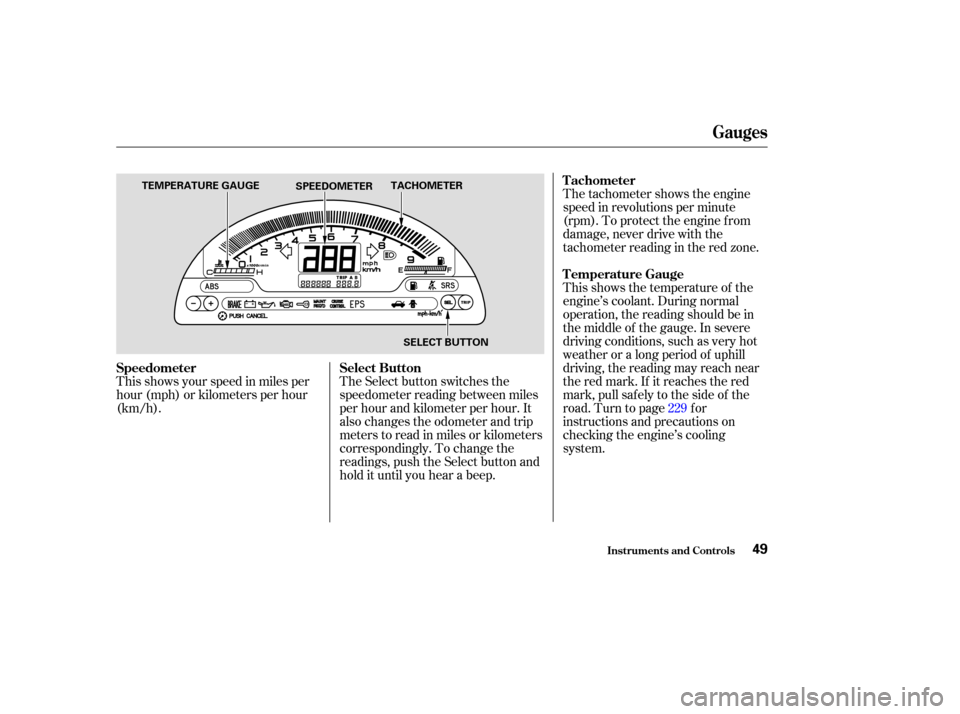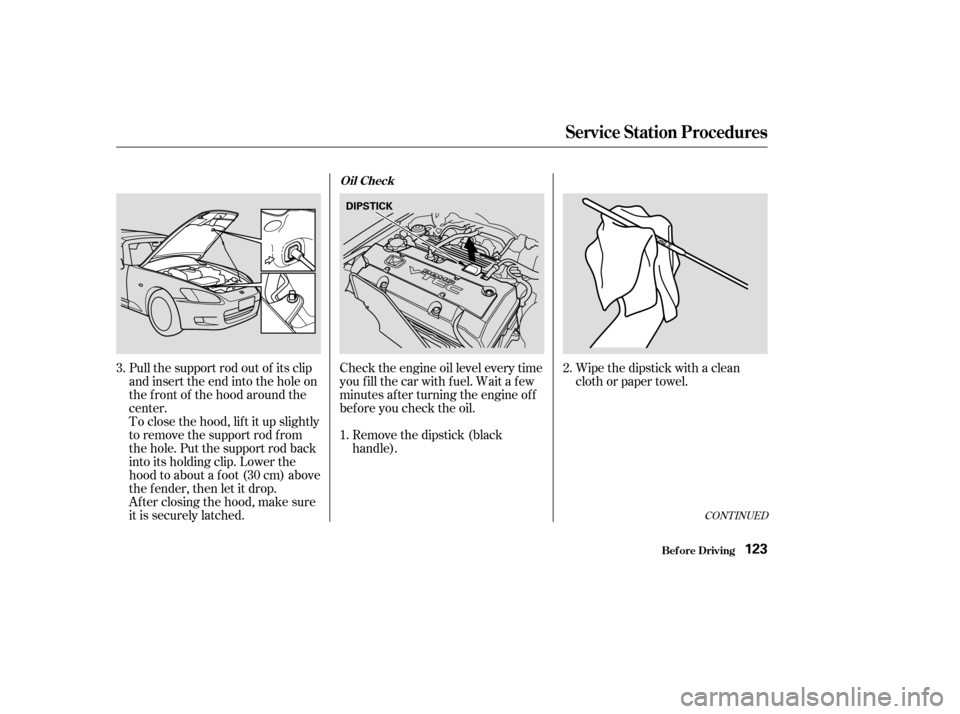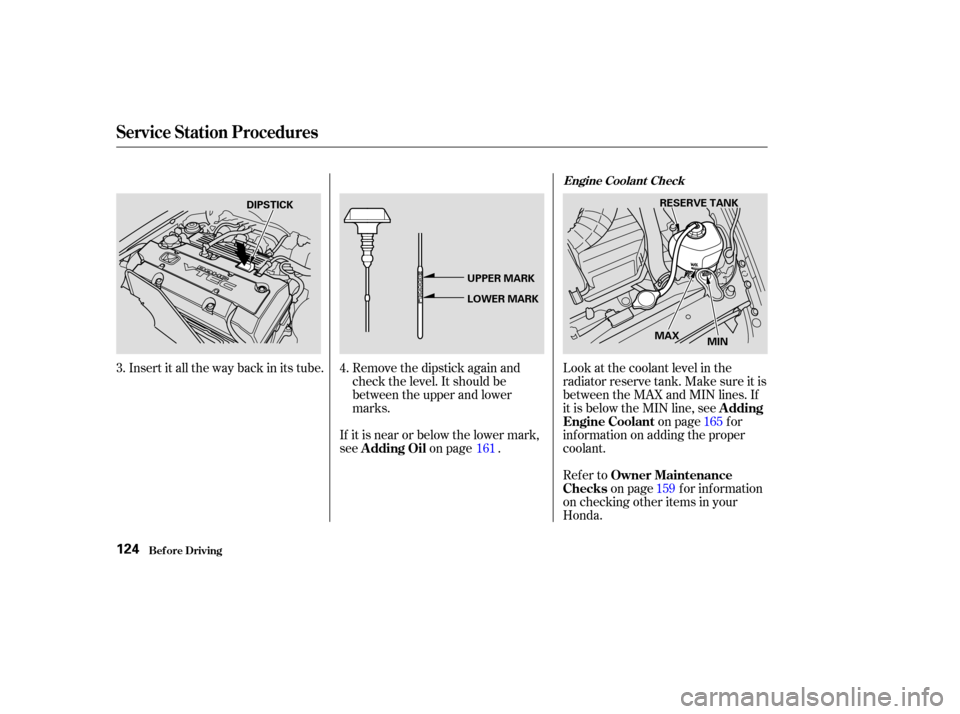check engine HONDA S2000 2003 1.G Owners Manual
[x] Cancel search | Manufacturer: HONDA, Model Year: 2003, Model line: S2000, Model: HONDA S2000 2003 1.GPages: 280, PDF Size: 3.9 MB
Page 19 of 280

See page f or additional
inf ormation about your seat belt
system and how to take care of your
belts. If a seat belt does not seem to work
as it should, it may not protect the
occupant in a crash.Anyone using a seat belt that is
not working properly can be
seriously injured or killed. Have your
Honda dealer check the belt as soon
as possible. After occupants have adjusted their
seats and put on seat belts, it is very
important that they continue to sit
upright, well back in their seats, with
their feet on the floor, until the car is
parked and the engine is of f .
Sitting improperly can increase the
chance of injury during a crash. For
example, if an occupant slouches,
lies down, turns sideways, sits
forward, leans forward or sideways,
or puts one or both f eet up, the
chance of injury during a crash is
greatly increased.
In addition, an occupant who is out of
position can be seriously or f atally
injured by striking interior parts of
thecar,orbybeingstruckbyan
inf lating airbag.Remember, to get the best
protection f rom your car’s airbags
and other safety features, you must
sit properly and wear your seat belt
properly.
33
Driver and Passenger Saf ety
Protecting Adults
No one should
sit in a seat wit h an inoperat ive seat belt.
Maintain a Proper Sitting
Position
5.
16
Sitting improperly or out of
position can result in serious
injury or death in a crash.
Always sit upright, well back in
the seat, with your feet on the
floor.
Page 41 of 280

If the light comes on or f lashes on
andoff whileyoudrive.
If you see any of these indications,
your airbags and seat belt tensioners
may not deploy when you need them.
See your Honda dealer as soon as
possible.
Thepurposeof theSRS
light is to alert you to a
potential problem with your
Supplemental Restraint System.
When you turn the ignition ON (II),
this indicator will light brief ly then
go out. This tells you that the system
is working properly.
If the light comes on at any other
time, or does not come on at all, you
should have the system checked by
your dealer. For example:
If the SRS indicator light does not
come on after you turn the ignition
switch to ON (II).
If the light stays on after the
engine starts.
Additional Inf ormation About Your SRS
Driver and Passenger Saf ety
How the SRS Indicator L ight
Works
38
Ignoring the SRS indicator light
can result in serious injury or
death if the airbags do not
inflate when needed.
Have your vehicle checked by a
dealer as soon as possible if
the SRS light alerts you to a
potential problem.
Page 49 of 280

This light has two f unctions:
If this light comes on when the
engine is running, the battery is not
being charged. For complete
inf ormation, see page . The engine can be severely damaged
if this light f lashes or stays on when
the engine is running. For complete
inf ormation, see page .
The instrument panel has many
indicators to give you important
inf ormation about your car.
If you do not f asten your seat belt,
the beeper will stop af ter a f ew
seconds but the light stays on until
you do. Both the light and the beeper
stay of f if you f asten your seat belt
bef ore turning on the ignition. This indicator f lashes f or several
seconds when you turn the ignition
ON (II). It f lashes as a reminder to
you and your passenger to f asten the
seat belts. A beeper also sounds if
you have not f astened your seat belt.
This indicator comes on when you
turn the ignition switch ON (II). It
is a reminder to check the parking
brake. Driving with the parking
brake not f ully released can
damage the brakes and tires.
If the indicator remains lit after
you have f ully released the
parking brake while the engine is
running, or if it comes on while
driving, it can indicate a problem
in the brake system. For complete
inf ormation, see page .
2. 1.
232
233
236
Parking Brake and
Brake System Indicator
L ow Oil Pressure
Indicator
Charging System
Indicator
Seat Belt Reminder L ight
Inst rument s and Cont rols
Indicator L ights
46
U.S. Canada
Page 50 of 280

This indicator lights when you turn
the ignition switch ON (II). If it
comes on at any other time, it
indicates a problem in the
supplemental restraint system. For
complete inf ormation, see page .
This light normally comes on f or a
f ew seconds when you turn the
ignition switch ON (II), and when
you push the START button. If this
light comes on at any other time,
there is a problem in the ABS. If this
happens, take the car to your dealer
to have it checked. With the light on,
your car still has normal braking
ability but no anti-lock.See page .
This light comes on if the trunk lid is
not closed tightly.
This light comes on if either door is
not closed tightly.
This light normally comes on when
you turn the ignition ON (II) and
goes of f af ter the engine starts. If it
comes on at any other time, there is
a problem in the Electric Power
Steering system. If this happens,
stop the car in a safe place and turn
of f the engine. Reset the system by
restarting the engine, and watch the
EPS light. If it does not go of f , or
comes back on again while driving,
take the car to your dealer to have it
checked. With the light on, the EPS
is turned off, making the car harder
to steer.
38
234
Supplemental Restraint
System Indicator
Anti-lock Brake System (ABS)
Indicator Malf unction Indicator
Lamp
Trunk-open Indicator
Door-open Indicator
Electric Power Steering
(EPS) Indicator
Indicator L ights
Inst rument s and Cont rols47
U.S. Canada
Page 52 of 280

The tachometer shows the engine
speed in revolutions per minute
(rpm). To protect the engine f rom
damage, never drive with the
tachometerreadingintheredzone.
This shows the temperature of the
engine’s coolant. During normal
operation, the reading should be in
the middle of the gauge. In severe
driving conditions, such as very hot
weather or a long period of uphill
driving, the reading may reach near
the red mark. If it reaches the red
mark, pull saf ely to the side of the
road. Turn to page for
instructions and precautions on
checking the engine’s cooling
system.
The Select button switches the
speedometer reading between miles
perhourandkilometerperhour.It
also changes the odometer and trip
meters to read in miles or kilometers
correspondingly. To change the
readings, push the Select button and
hold it until you hear a beep.
This shows your speed in miles per
hour (mph) or kilometers per hour
(km/h).
229
Gauges
Inst rument s and Cont rols
T achometer
Select Button Temperature Gauge
Speedometer
49
TEMPERATURE GAUGE SPEEDOMETERTACHOMETER
SELECT BUTTON
Page 122 of 280

Bef ore you begin driving your Honda,
youshouldknowwhatgasolineto
use, and how to check the levels of
important f luids. You also need to
know how to properly store luggage
or packages. The inf ormation in this
section will help you. If you plan to
add any accessories to your vehicle,
please read the inf ormation in this
section f irst..............................
Break-in Period .120
.........................................
Gasoline .120
.........
Service Station Procedures . 121
................
Filling the Fuel Tank . 121
....................
Opening the Hood .122
...............................
Oil Check .123
.........
Engine Coolant Check . 124
...............................
Fuel Economy .125
............................
Car Condition .125
...........................
Driving Habits .125
...
Accessories and Modif ications . 126
................................
Accessories .126
............................
Modif ications .127
...
Additional Safety Precaution . 127
.............................
Carrying Cargo .128
.....................
General Precautions .131
Bef ore Driving
Bef ore Driving119
Page 126 of 280

Pull the support rod out of its clip
and insert the end into the hole on
the f ront of the hood around the
center.
To close the hood, lif t it up slightly
to remove the support rod f rom
the hole. Put the support rod back
into its holding clip. Lower the
hood to about a f oot (30 cm) above
the fender, then let it drop.
After closing the hood, make sure
it is securely latched.Check the engine oil level every time
you f ill the car with f uel. Wait a f ew
minutes af ter turning the engine of f
bef ore you check the oil.
Remove the dipstick (black
handle). Wipe the dipstick with a clean
cloth or paper towel.
1.
3.
2.
CONT INUED
Oil Check
Service Station Procedures
Bef ore Driving123
DIPSTICK
Page 127 of 280

Insert it all the way back in its tube. Remove the dipstick again andcheck the level. It should be
between the upper and lower
marks.
If it is near or below the lower mark,
see on page . Look at the coolant level in the
radiator reserve tank. Make sure it is
between the MAX and MIN lines. If
it is below the MIN line, see
on page f or
inf ormation on adding the proper
coolant.
Refer to on page f or inf ormation
on checking other items in your
Honda.
3.
4.
161 159165
Service Station Procedures
Bef ore Driving
A dding Oil
A dding
Engine Coolant
Owner Maintenance
Checks
Engine Coolant Check
124
UPPER MARK
LOWER MARK
DIPSTICK
RESERVE TANK
MAX MIN
Page 128 of 280

You can improve f uel economy by
driving moderately. Rapid acceler-
ation, abrupt cornering, and hard
braking use more f uel.
Always drive in the highest gear that
allows the engine to run and acceler-
ate smoothly.
A cold engine uses more f uel than a
warm engine. It is not necessary to
‘‘warm-up’’ a cold engine by letting it
idle f or a long time. You can drive
away in about a minute, no matter
how cold it is outside. The engine
will warm up f aster, and you get
better f uel economy. To cut down on
the number of ‘‘cold starts,’’ try tocombine several short trips into one.
The condition of your car and your
driving habits are the two most
important things that affect the fuel
mileage you get.
Always maintain your car according
to the maintenance schedule. This
will keep it in top operating condition.
Depending on traf f ic conditions, try
to maintain a constant speed. Every
time you slow down and speed up,
your car uses extra f uel. Use the
cruise control, when appropriate, to
increase f uel economy.The air conditioning puts an extra
load on the engine which makes it
usemorefuel.Turnoff theA/Cto
cut down on air conditioning use.
Use the f low-through ventilation
when the outside air temperature is
moderate.
In winter, the build-up of snow on
your car’s underside adds weight and
rolling resistance. Frequent cleaning
helps your f uel mileage and reduces
thechanceof corrosion. An important part of that mainte-
nance is the (see page ). For
example, an underinf lated tire
causes more ‘‘rolling resistance,’’
which uses f uel. It also wears out
f aster, so check the tire pressure at
least monthly. 159 Driving Habits
Car Condition
Owner Maintenance
Checks
Bef ore Driving
Fuel Economy
125
Page 137 of 280

Make sure all windows, mirrors,
and outside lights are clean and
unobstructed. Remove f rost, snow,
or ice.Check that any items you may be
carrying with you inside are stored
properly or f astened down
securely.
Check the adjustment of the seat
(see page ).
Check the adjustment of the
inside and outside mirrors (see
page ).Fasten your seat belt. Check that
your passenger has f astened his or
her seat belt (see page ).
Turn the ignition switch ON (II).
Check the indicator lights in the
instrument panel.
Start the engine (see page ).
Check the gauges and indicator
lights in the instrument panel (see
page ).
Visually check the tires. If a tire
looks low, use a gauge to check its
pressure.
Youshoulddothefollowingchecks
and adjustments every day bef ore
you drive your car.
Check that the hood and trunk are
f ully closed. Make sure the doors are securely
closed and locked.
1.
2.
3. 4.
5.
6.
7.8.
9.
10.
11. 15
69
80 45135
Driving
Preparing to Drive
134